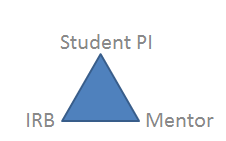 by Bruce W. Kennedy, MS, RLATG, CMAR, CPIA, compliance associate at the California State Polytechnic University, Pomona
by Bruce W. Kennedy, MS, RLATG, CMAR, CPIA, compliance associate at the California State Polytechnic University, Pomona
Ten years ago, I started as compliance associate at the California State Polytechnic University, Pomona. My position fell under the school’s newly created Office of Research, and my responsibilities centered around regulatory tasks that had previously been performed “on-the-side” by others. Early on it was recognized that better practices and policies were needed to serve principal investigators (PIs) working in human subjects and animal research. My assignment was to further develop the program, which I did through membership in PRIM&R, studying for my Certified Professional IACUC Administration (CPIA®) credential, and consulting with colleagues.
Now, I work primarily with social, behavioral, and educational research (SBER) protocols submitted by students and their faculty mentors. Fortunately, access to information about SBER is even easier thanks to webinars like Reviewing Student Research: Best Practices and Future Directions, which was presented by J. Michael Oakes, PhD, and Amy King, MPH, in July. I initially signed up for the webinar hoping it would validate the program we’ve implemented at my institution, and more importantly, give us ideas for improvements. I was not disappointed.
One issue that the webinar touched on was what constitutes generalizable knowledge, which is no clearer when it comes to student SBER, than it is with biomedical research. Often students carve out a piece of a larger study being conducted by a professor for their research. The data from the student’s research is then used to inform the larger research project, and, as a result, may contribute to generalizable knowledge more directly. However, in my experience, there are also many undergraduate and graduate students working independently.
Given the inexperience of most students doing research, Dr. Oakes and Ms. King suggested requiring students to have a faculty mentor, which is a recommendation with which I agree. At my institution, students are allowed to serve as the PI, which makes them more “responsible” for the research. However, they don’t go at it alone—a mentor works with them and is included on all correspondence as the protocol goes through IRB review.

Along the same lines, Dr. Oakes and Ms. King suggested that IRBs should aim to help students become good researchers. Teaching students about ethics, systematic inquiries, and regulatory compliance can benefit them in the short term, as well as later in life. The image of the triangle, at right, illustrates one way of thinking about the relationship between IRBs, students conducting research, and their faculty mentors. The student is at the top, leading the research, while the IRB and the mentor are at the base, lending their support to the student throughout the process.
Based on the advice of Ms. King and Dr. Oakes, I plan to implement formal IRB advising hours— a “research concierge,” if you will. Up until now, it has been rather piecemeal, but I increasingly see the value of conducting face-to-face reviews with students versus a more sterile, emailed listing of issues with a given protocol. Another idea that was shared during the webinar was the creation of a student-driven IRB to minimize harms and risks—by providing a more local and immediate review—and to help students understand the IRB process.
Ultimately, critical thinking skills are necessary for students, and they can be developed and gained by doing research. By involving the IRB and utilizing established processes, student understanding of science and discovery can be enhanced. As Ms. King and Dr. Oakes described in the webinar, IRBs have a unique opportunity to foster regulatory compliance and augment the learning experience of students.
Interested in checking out this webinar? The archive for Reviewing Student Research: Best Practices and Future Directions is available for purchase.

No comments! Be the first commenter?